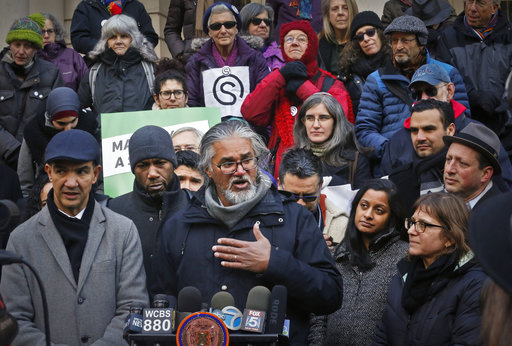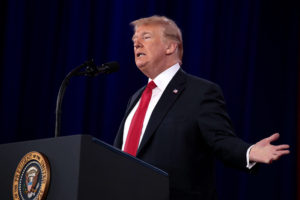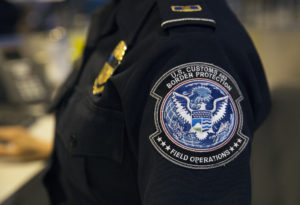Did NYPD Overstep in ICE Deportation of Activist?
Ravi Ragbir’s case raises questions about what it means to be a “sanctuary city.” Ravi Ragbir, center, a citizen of Trinidad and Tobago and executive director of the New Sanctuary Coalition of New York City, at a press conference held on his behalf in January at New York City Hall. (Bebeto Matthews / AP)
Ravi Ragbir, center, a citizen of Trinidad and Tobago and executive director of the New Sanctuary Coalition of New York City, at a press conference held on his behalf in January at New York City Hall. (Bebeto Matthews / AP)
Immigration and Customs Enforcement (ICE) has been promoting the Trump administration’s goal of deporting undocumented immigrants as quickly as possible. Federal courts and “sanctuary cities” have acted as a hindrance to these efforts, but a recent case involving immigration activist Ravi Ragbir raises questions about the authority of these entities in challenging federal immigration policy.
Ragbir, director of the New Sanctuary Coalition of New York City, had a green card when he was convicted of wire fraud in 2000. He served a prison sentence and was ordered to be deported in 2006, but he was released on an order of supervision while he appealed his case. He was allowed to stay in the country as long as he completed periodic check-ins with ICE, but at his Jan. 11 check-in at the agency’s New York office he was taken into custody after being told that he had exhausted his appeals. Ragbir fainted at the office and was afterward placed in handcuffs and put in an ambulance with ICE officials.
According to The Intercept, supporters of Ragbir outside the agency building attempted to block the ambulance in an effort to prevent his deportation. Federal Protective Services officers and members of the New York Police Department’s Strategic Response Group tried to clear the crowd to allow the ambulance to pass. The crowd moved with it for several blocks before the vehicle was able to transport Ragbir and the ICE officers to Bellevue Hospital in Manhattan. After he was examined, Ragbir was taken to the Newark International Airport and sent to the Krome Detention Center in Florida.
Eighteen protesters were taken into custody during the New York incident in arrests that included “tearing clothes, slamming nonviolent protesters to the ground, and in several instances, choking people,” according to The Intercept. One officer who was involved is being transferred out of the Strategic Response Group as a result of an investigation.
The incident is especially significant given that a New York City law that forbids the use of city resources for immigration enforcement went into effect Jan. 11.
The Intercept continues:
NYPD officials and spokespeople for Mayor Bill de Blasio have consistently maintained that the police’s actions that day did not constitute collaboration with ICE, and that officers were simply responding to the public safety concerns presented by the protest. De Blasio issued a letter in support of Ragbir this week and has placed the blame for the events of January 11 on a “very purposeful and provocative action” by ICE. …
The questions go to the heart of what it means to be a “sanctuary city” — an already contested and malleable term — in the age of the Trump administration’s escalating deportation regime, and how far city officials are prepared to go to protect undocumented New Yorkers. For some city council members, the NYPD’s answers were not reassuring, with the police at one point awkwardly denying that their vehicular accompaniment to a deportation constituted an “escort” or cooperation at all.
“What happened on that day was some sort of coordination,” said an exasperated City Council Member Jumaane Williams, who was arrested at the January 11 protest. “You can’t pretend that it didn’t happen.” He went on: “You were enforcing local laws and I get it, but that was helping someone be deported, period.”
An NYPD lawyer responded to Williams that the charge of police participation in immigration enforcement that day was itself “dangerous.”
One key issue is that NYPD officers accompanied ICE officials from the hospital to the entrance of the Holland Tunnel, which connects Manhattan to Jersey City, N.J., as the ICE officials were en route from the hospital to the Newark International Airport. New York City Councilman Brad Lander told police at a hearing last Wednesday that the NYPD overstepped its jurisdiction by continuing to be present after Ragbir’s arrival at the hospital.
“Up to that point, you guys were responding to a protest,” Lander said. “But at Bellevue, there was no protest. There were no protesters. No one knew he was there until after he was there, and from Bellevue to the Holland Tunnel, I don’t see one iota of reason to believe that there was a public safety risk, and I don’t really believe it was derivative of the protest. So I don’t believe it should have happened.”
Ragbir had been scheduled to be deported to Trinidad and Tobago on Saturday, but that was put on hold when his lawyers filed a lawsuit in Manhattan earlier in the week.
The New York Times continues:
The government agreed to delay his removal until the court can decide whether his rights have been violated.
His case was one of a growing number in which federal judges have ruled to halt both individual and mass deportations. Last week, a judge in a New Jersey district court temporarily stopped the deportation of Indonesian Christians, longtime community members in Highland Park, N.J., who had been swept up by immigration agents. A day earlier, in Boston, a judge made a similar ruling in the case of 50 Indonesian Christians, and in December, a Miami judge halted the deportation of 92 Somalis. In June, a judge in Detroit halted the deportation of more than a hundred Iraqi Christians, and then expanded the ruling to cover a class of as many as 1,400 people
These federal judges are not deciding immigration cases, over which they have no jurisdiction, but rather giving people time to fight in the immigration courts. They are slowing deportations by insisting that undocumented immigrants still have the right of due process, even if in many of these cases, the immigrants had known for years that they could be expelled.
Immigration officials were not pleased with the judge’s decision to delay Ragbir’s deportation.
“I am increasingly troubled by orders from federal judges halting the deportation of certain groups of individuals, all of which appear to ignore the fact that each alien in question was lawfully ordered removed from the United States after full and fair proceedings, many of which lasted several years or longer, at great taxpayer expense,” ICE Deputy Director Thomas Homan said.
But Lee Gelernt, a lawyer with the American Civil Liberties Union, countered that the Trump administration is moving “abruptly” to deport immigrants “without giving them a fair chance to go to immigration court.” Gelernt said he thought judges were “being very careful not to go beyond what they have legal authority of what they can do.”
Stephen Legomsky, a professor of immigration law at Washington University School of Law in St. Louis, told The New York Times that judges in cases like Ragbir’s are responding to the aggressiveness of immigration officials. “Generally, when the political branches do extreme things, judges will respond with more and more constraints,” he said.
Your support matters…Independent journalism is under threat and overshadowed by heavily funded mainstream media.
You can help level the playing field. Become a member.
Your tax-deductible contribution keeps us digging beneath the headlines to give you thought-provoking, investigative reporting and analysis that unearths what's really happening- without compromise.
Give today to support our courageous, independent journalists.






You need to be a supporter to comment.
There are currently no responses to this article.
Be the first to respond.